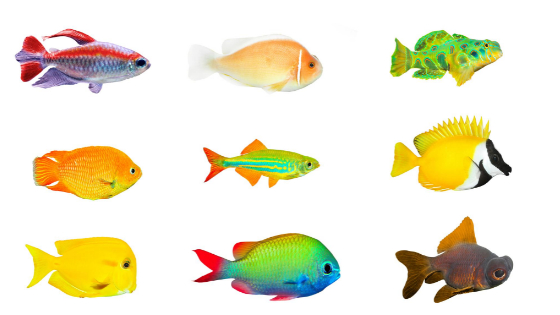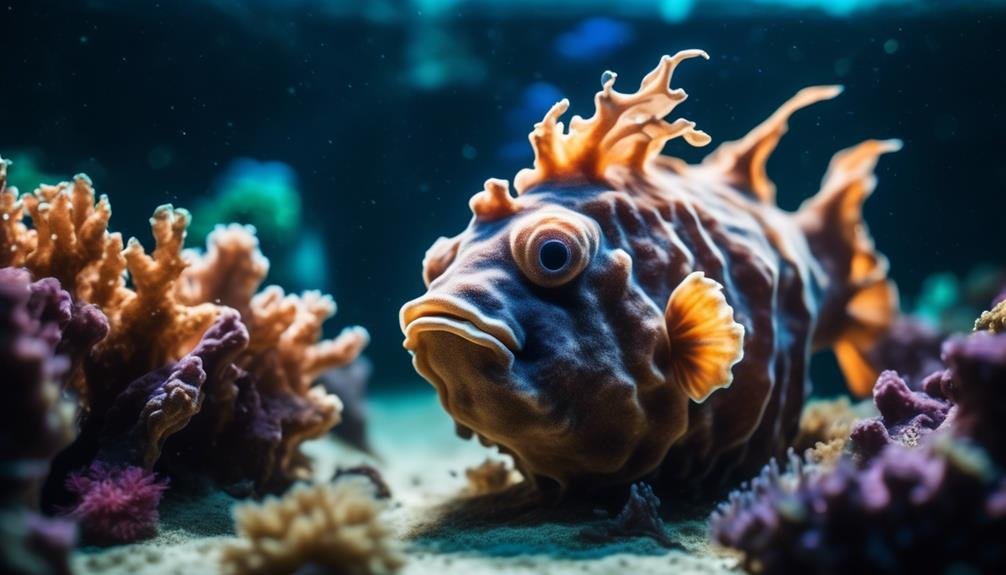
Looking to add a sense of wonder and intrigue to your aquarium? Ever wondered how some creatures can effortlessly disappear into their surroundings? Well, have you ever heard of the mysterious frogfish?
These intriguing creatures are true masters of camouflage, capable of seamlessly blending into their environment with their unique physical adaptations. But how exactly do they do it? And what secrets lie behind their uncanny ability to vanish before your eyes?
In this discussion, we will unravel the secrets of the enigmatic frogfish, exploring their fascinating world and discovering the mesmerizing ways in which they adapt to their surroundings.
Get ready to be captivated by these masters of disguise in your aquarium.
Key Takeaways
- Frogfish require a medium to large aquarium with enough space for swimming and hiding.
- Suitable tank mates should be chosen carefully, considering their size and temperament.
- Frogfish are saltwater fish commonly found in subtropical and tropical oceans and seas.
- Their unique physical adaptations allow them to camouflage among corals and rock reefs.
Tank Requirements
You’ll need to meet specific tank requirements to provide a suitable habitat for frogfish in your aquarium. A medium to large aquarium is needed, giving them enough space to swim and hide. This also allows for the addition of suitable tank mates.
Maintaining suitable water conditions for frogfish, such as sub-tropical to tropical temperatures, is important. Weekly care and maintenance, including pH monitoring, are required, as they prefer slightly alkaline water.
Frogfish are relatively easy to care for, but providing suitable tank mates is necessary for their well-being. They should be kept with non-aggressive species that aren’t small enough to be viewed as prey.
Care and Maintenance
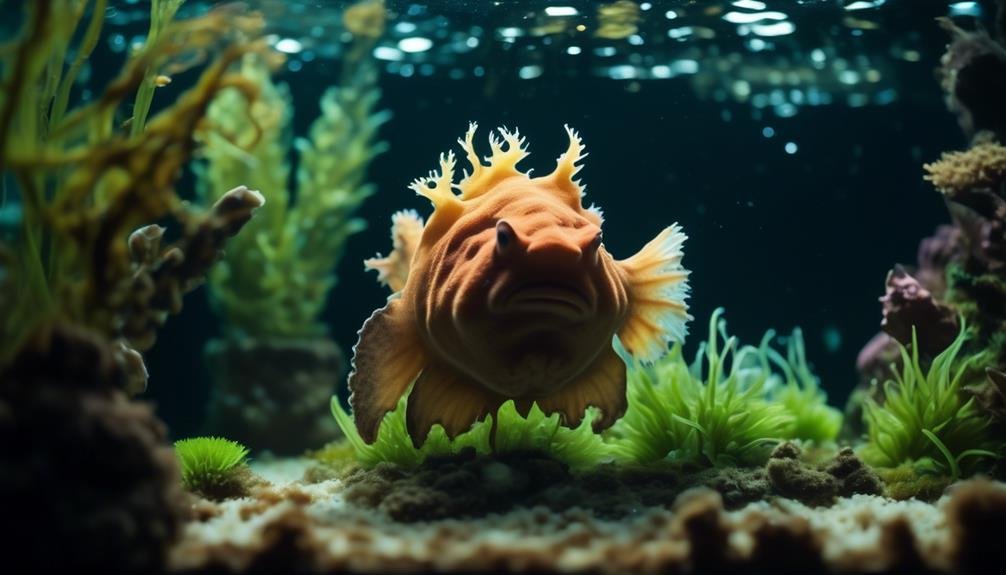
Regular attention and upkeep are necessary to properly care for and maintain your frogfish in your aquarium. Weekly care and maintenance are required to ensure the well-being of your frogfish. It is important to provide suitable, non-aggressive tank mates and not small enough to be viewed as prey. Careful consideration should be given to the size and temperament of the tank mates. Creating a community environment is essential for the overall health of your frogfish. Monitoring the water conditions, such as temperature and pH level, is crucial. Frogfish prefer sub-tropical to tropical temperatures and slightly alkaline water. By providing a spacious tank with suitable water conditions and proper care, you can ensure the longevity and happiness of your mysterious frogfish.
| Care and Maintenance |
|---|
| Regular attention and upkeep are necessary for frogfish. |
| Weekly care and maintenance is required. |
| Suitable tank mates are necessary for their well-being. |
| Monitoring water conditions is important. |
Habitat and Distribution
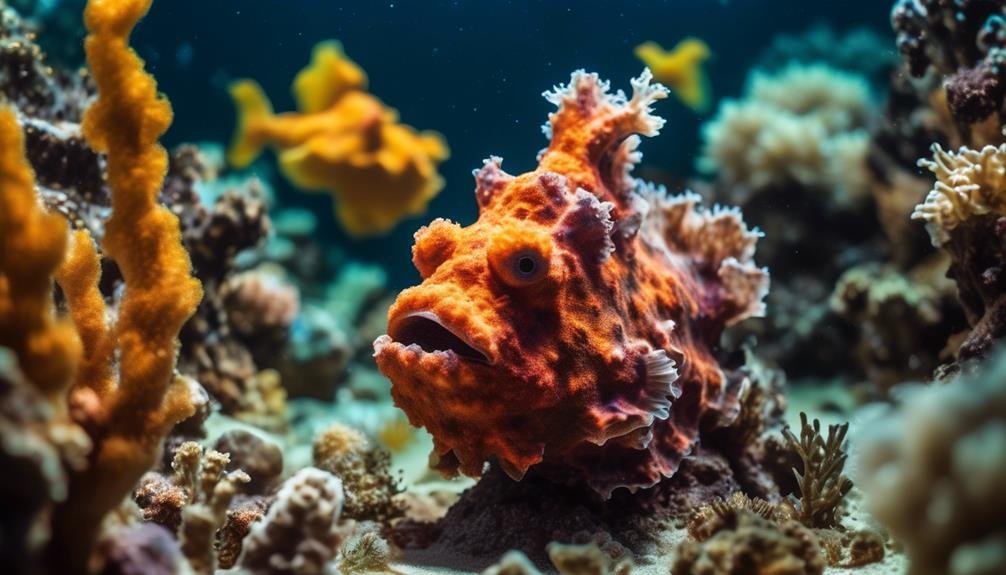
Frogfish, fascinating members of the anglerfish family, can be found in subtropical and tropical oceans and seas across the Atlantic, Pacific, Indian Oceans, and the Red Sea. They aren’t found in the Mediterranean Sea.
Here are four interesting facts about their habitat and distribution:
- The wide distribution of frogfish showcases their adaptability and ability to thrive in various environments.
- The fact that they can be found in multiple oceans and seas highlights their global presence and importance in marine ecosystems.
- Their ability to camouflage among coral and rock reefs allows them to blend seamlessly into their surroundings, making them difficult to spot.
- The presence of frogfish in subtropical and tropical waters reminds us of the beauty and diversity of marine life beneath the surface.
Suitable Tank Mates
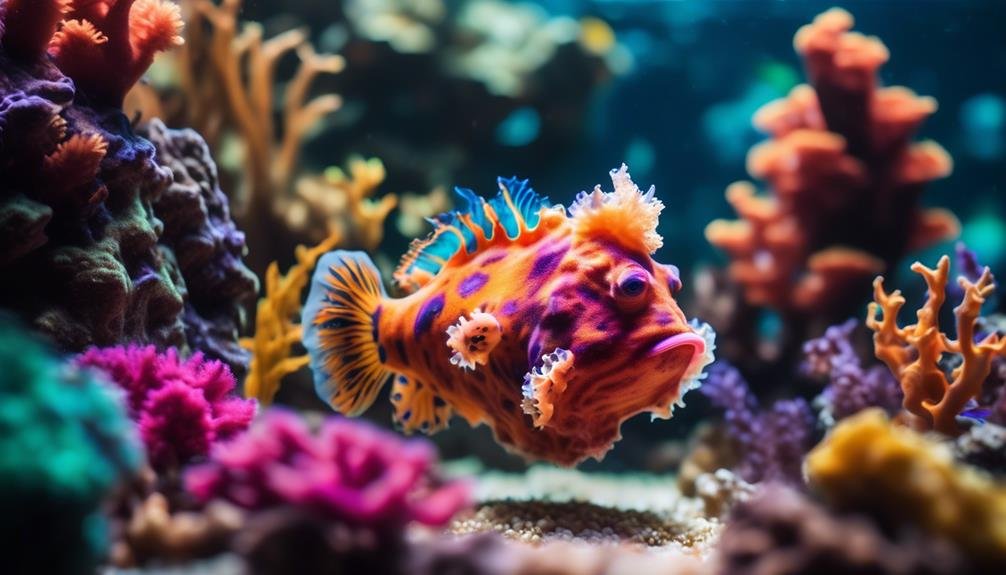
Their adaptability and ability to thrive in various environments extend beyond their natural habitat – even in an aquarium, suitable tank mates are important for the well-being of frogfish.
When choosing tank mates for your frogfish, it’s crucial to consider their size and temperament. Frogfish should be kept with non-aggressive species that aren’t small enough to be viewed as prey. Peaceful fish species are generally suitable for cohabitation.
Creating a community environment in the aquarium is essential for the well-being of frogfish. Additionally, providing live rock and sandy substrate allows them to burrow and feel secure.
Swimming Behavior and Adaptations
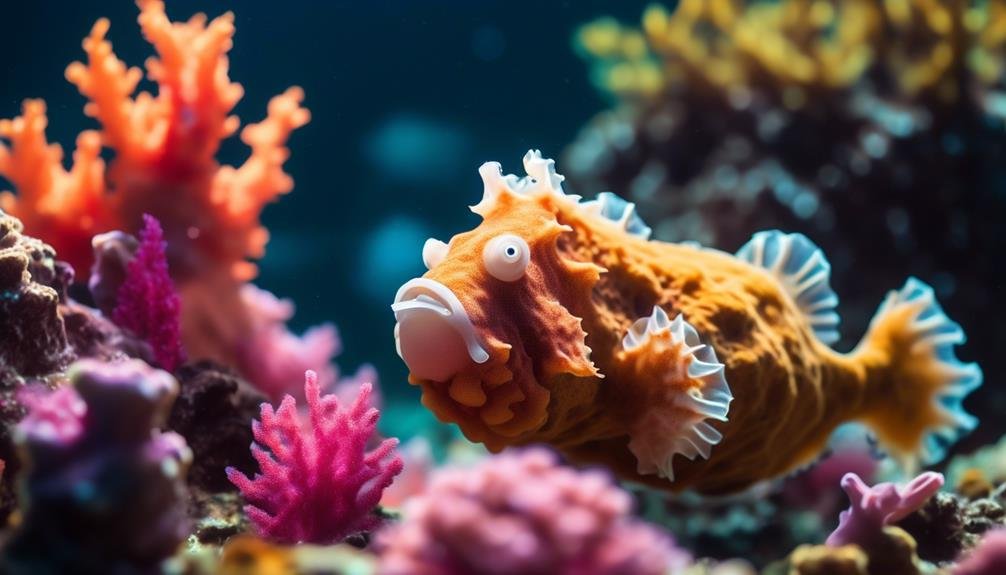
When keeping frogfish in your aquarium, their swimming behavior and unique adaptations are worth noting. Here are four fascinating aspects to consider:
- Astonishing Camouflage: Frogfish possess remarkable abilities, blending seamlessly with their surroundings, such as corals and rock reefs. Witnessing their incredible ability to mimic their environment is truly a marvel.
- Masters of the Bottom: These enigmatic creatures predominantly swim in the lower regions of the water column. Their swimming behavior is limited to this area, making them highly adapted to life near the bottom of the tank.
- Burrowing Experts: Providing live rock and sandy substrate in the aquarium allows frogfish to exhibit their burrowing skills. Watch as they disappear into the substrate, showcasing their natural digging behavior.
- Unique Physiology: Frogfish are renowned for their distinct physical appearance and adaptations. From their expandable mouths to their modified fins resembling legs, these adaptations enable them to navigate their environment and precisely capture prey.
As you observe these mesmerizing creatures in your aquarium, marvel at their swimming behavior and fascinating adaptations that make them truly masters of camouflage.
Feeding Habits

As you continue exploring the fascinating world of frogfish in your aquarium, let’s focus on their feeding habits.
Frogfish are voracious predators and have unique feeding strategies. They’re ambush predators, patiently waiting for their prey to come within striking distance. Once their prey is within reach, they use their rapid mouth suction to engulf it in a split second. Their large mouths and expandable stomachs allow them to consume prey much larger than their body size.
Frogfish are opportunistic feeders with diverse diets, including small fish, crustaceans, and even other frogfish. In your aquarium, it’s important to provide them with various live or frozen foods to ensure their nutritional needs are met.
Observing their feeding behavior can be both fascinating and rewarding.
Breeding and Reproduction

To successfully breed and reproduce frogfish in your aquarium, it’s important to understand their unique reproductive behaviors and provide the necessary conditions for their breeding success. Here are four key factors to consider:
- Mating Rituals: Frogfish engage in elaborate courtship rituals, including visual displays and tactile interactions. Witnessing these intimate moments can be a truly mesmerizing experience, showcasing the beauty and complexity of nature.
- Egg Laying: Female frogfish produce gelatinous egg masses that adhere to surfaces in the tank. Watching the female carefully attach and protect her eggs can evoke a sense of wonder and appreciation for these remarkable creatures’ dedication and instinctual behaviors.
- Parental Care: Male frogfish play an active role in the reproductive process by guarding and protecting the eggs until they hatch. Observing the male diligently guarding the nest can evoke feelings of admiration for their dedication to ensuring the survival of their offspring.
- Hatching and Fry Development: Witnessing the hatching of the eggs and the subsequent development of the tiny fry can invoke a sense of awe and excitement. Seeing these miniature versions of their parents swim and grow can be a rewarding and joyful experience.
Common Species of Frogfish

Now, let’s dive into the fascinating world of frogfish by exploring the species commonly found in aquariums.
One common species is the Antennarius commersoni, the Commerson’s frogfish. It has a stocky body, a large mouth, and a lure on its head to attract prey.
Another popular species is the Antennarius maculatus, or the Clown frogfish. It has bright colors and patterns resembling a clown’s face, making it a favorite among aquarium enthusiasts.
The Histiophryne pogonius, or the Hairy frogfish, is another species commonly seen in aquariums. It has a unique appearance with its ‘hair-like’ appendages and specialized skin adaptations.
These are just a few examples of the fascinating and diverse species of frogfish that you can find in aquariums.
Tips for Keeping Frogfish in Your Aquarium

Keeping frogfish in your aquarium requires careful consideration of their specific needs and requirements. To ensure the well-being of these fascinating creatures, here are some important tips to follow:
- Provide a spacious tank: Frogfish need enough space to swim and hide. A medium to large aquarium is recommended to accommodate their needs and allow for the addition of suitable tank mates.
- Maintain suitable water conditions: Frogfish require sub-tropical to tropical temperatures and slightly alkaline water. Regularly monitoring pH levels is crucial to create a suitable environment for them.
- Care for tank mates: Choose non-aggressive fish species as tank mates. Consider their size and temperament to avoid any conflicts. Creating a peaceful community environment is essential for the well-being of frogfish.
- Perform regular care and maintenance: Weekly care and maintenance, including water changes and monitoring, are necessary to keep the aquarium clean and provide a healthy habitat for frogfish.
Frequently Asked Questions
What Are the Feeding Habits of Frogfish?
The feeding habits of frogfish involve their ability to camouflage and lure prey. They patiently wait for smaller fish or crustaceans to come close, then use their quick reflexes to snatch them up with their expandable mouths.
How Do Frogfish Reproduce, and What Is Their Breeding Behavior?
Frogfish reproduce through external fertilization. The female lays eggs on a substrate, and the male releases sperm to fertilize them. After hatching, the larvae drift in the water until they become juvenile frogfish.
Are There Any Specific Species of Frogfish That Are Commonly Found in Aquariums?
Yes, there are specific species of frogfish commonly found in aquariums. They can include the Antennarius pictus, Antennarius commerson, and Antennarius maculatus. These species are popular choices due to their unique appearance and interesting behavior.
What Are Some Tips for Keeping Frogfish in Your Aquarium?
To keep frogfish in your aquarium, provide a medium to large tank with suitable water conditions. Choose tank mates wisely, ensuring they won’t be viewed as prey. Regular care and maintenance are necessary for their well-being.
Can Frogfish Change Their Color and Camouflage Pattern?
Yes, frogfish can change their color and camouflage pattern. They can blend in with their surroundings, making them masters of disguise. This helps them to hide from predators and ambush their prey.
Can Frogfish and Unicornfish Coexist in the Same Aquarium?
Yes, frogfish and colorful unicornfish aquatic jewel can coexist in the same aquarium as long as the tank is large enough to accommodate both species. However, it is important to carefully monitor their interactions and make sure they have enough hiding spots to minimize potential conflicts.
Conclusion
In conclusion, adding frogfish to your aquarium is a surefire way to bring mystery and intrigue to your underwater world. With their incredible camouflage abilities and unique physical adaptations, these masters of disguise are a sight to behold.
By providing the right tank requirements, suitable tank mates, and proper care and maintenance, you can create a thriving environment for these captivating creatures.
So don’t hesitate; get ready to be amazed by the enigmatic frogfish in your home aquarium.




